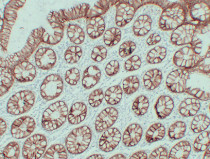ARG66487
anti-Claudin 4 antibody
anti-Claudin 4 antibody for IHC-Formalin-fixed paraffin-embedded sections,Western blot and Human
Overview
| Product Description | Mouse Monoclonal antibody recognizes Claudin 4 |
|---|---|
| Tested Reactivity | Hu |
| Tested Application | IHC-P, WB |
| Host | Mouse |
| Clonality | Monoclonal |
| Isotype | IgG2b, kappa |
| Target Name | Claudin 4 |
| Antigen Species | Human |
| Immunogen | Synthetic peptide derived from Human Claudin 4. |
| Conjugation | Un-conjugated |
| Alternate Names | CPE-R; Williams-Beuren syndrome chromosomal region 8 protein; hCPE-R; CPE-receptor; CPETR; CPETR1; Clostridium perfringens enterotoxin receptor; Claudin-4; CPER; WBSCR8 |
Application Instructions
| Application Suggestion |
|
||||||
|---|---|---|---|---|---|---|---|
| Application Note | IHC-P: Antigen Retrieval: Tris/EDTA buffer (pH 8.0) was used. * The dilutions indicate recommended starting dilutions and the optimal dilutions or concentrations should be determined by the scientist. |
||||||
| Observed Size | ~ 20 kDa |
Properties
| Form | Liquid |
|---|---|
| Purification | Affinity purification with immunogen. |
| Buffer | PBS, 0.02% Sodium azide, 50% Glycerol and 0.5% BSA. |
| Preservative | 0.02% Sodium azide |
| Stabilizer | 50% Glycerol and 0.5% BSA |
| Concentration | 1 mg/ml |
| Storage Instruction | For continuous use, store undiluted antibody at 2-8°C for up to a week. For long-term storage, aliquot and store at -20°C. Storage in frost free freezers is not recommended. Avoid repeated freeze/thaw cycles. Suggest spin the vial prior to opening. The antibody solution should be gently mixed before use. |
| Note | For laboratory research only, not for drug, diagnostic or other use. |
Bioinformation
| Database Links | |
|---|---|
| Gene Symbol | CLDN4 |
| Gene Full Name | claudin 4 |
| Background | The protein encoded by this intronless gene belongs to the claudin family. Claudins are integral membrane proteins that are components of the epithelial cell tight junctions, which regulate movement of solutes and ions through the paracellular space. This protein is a high-affinity receptor for Clostridium perfringens enterotoxin (CPE) and may play a role in internal organ development and function during pre- and postnatal life. This gene is deleted in Williams-Beuren syndrome, a neurodevelopmental disorder affecting multiple systems. [provided by RefSeq, Sep 2013] |
| Function | Plays a major role in tight junction-specific obliteration of the intercellular space. [UniProt] |
| Cellular Localization | Cell junction, tight junction. Cell membrane; Multi-pass membrane protein. Note=CLDN4 is required for tight junction localization in the kidney. [UniProt] |
| Calculated MW | 22 kDa |
| PTM | Phosphorylated. Phosphorylation by EPHA2 is stimulated by EFNA1 and alters interaction with TJP1. [UniProt] |
Images (3) Click the Picture to Zoom In
-
ARG66487 anti-Claudin 4 antibody IHC-P image
Immunohistochemistry: Paraffin-embedded Human colon stained with ARG66487 anti-Claudin 4 antibody at 1:200 (4°C, overnight). Antigen Retrieval: Tris/EDTA buffer (pH 8.0) was used.
-
ARG66487 anti-Claudin 4 antibody WB image
Western blot: 30 µg of LnCap whole cell lysate stained with ARG66487 anti-Claudin 4 antibody at 1:1000 dilution.
-
ARG66487 anti-Claudin 4 antibody IHC-P image
Immunohistochemistry: Paraffin-embedded Human pancreatic carcinoma stained with ARG66487 anti-Claudin 4 antibody at 1:200 (4°C, overnight). Antigen Retrieval: Tris/EDTA buffer (pH 8.0) was used.








